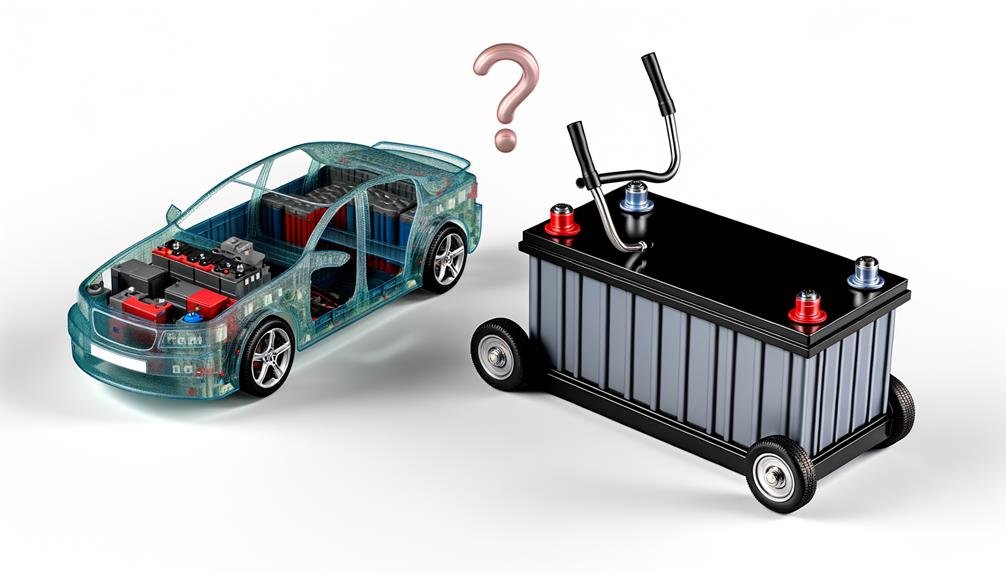Charles Miller is a veteran bike enthusiast with over 12 years of experience dealing with bikes as a mechanic. Despite immense love and expertise for...
While it may seem like an innovative idea to use a car battery for an electric bike—given their readily available nature and high power output—the viability and safety of such an application warrants a detailed discussion.
A preliminary understanding reveals that car batteries are structurally and functionally different from those designed for electric bikes, potentially leading to technical difficulties and safety issues.
However, the question remains: despite these potential pitfalls, could there be a scenario where the use of a car battery for an electric bike would be both feasible and safe?
To answer this question, a careful examination of the intricacies of both car and electric bike batteries is necessary.
- Key Takeaways
- Car Vs. Bike Battery Differences
- Possible Car Battery Usage on E-bikes
- Challenges of Car Battery Integration
- Ideal Power Sources for E-bikes
- Charging Ebike Off a Car: Steps
- Risks of Charging E-Bike From Car
- Benefits of Car Charging E-bikes
- Inverter Size for E-bike Charging
- Electric Bicycle Batteries Comparison
- Frequently Asked Questions
- Conclusion
Key Takeaways
- Car batteries are not suitable for use in electric bikes due to differences in voltage, power output, size, and design.
- Using a car battery in an electric bike can lead to technical failures, safety hazards, and compatibility issues.
- Repurposing retired EV batteries may offer a more viable and safer option for electric bikes.
- Lithium ebike batteries are the ideal power source for electric bikes, as they are specifically designed for compatibility, safety, and performance.
Car Vs. Bike Battery Differences
Diving into the technicalities, one can identify four key differences between car batteries and bike batteries, namely voltage and cranking amps, internal structure, size and power, and their specific design purposes.
Car batteries typically produce 12 volts of direct current (DC) and 600 cranking amps, while bike batteries produce 7 volts of DC and 150-200 cranking amps. This variation in voltage and cranking amps delineates the power capacity and energy output between the two, with cars requiring more power for ignition than bikes.
The internal structure further differentiates them. Car batteries contain lead plates, while bike batteries have smaller cells filled with electrolytes. This distinction contributes to the size discrepancy, with car batteries being larger and more powerful than their bike counterparts.
Possible Car Battery Usage on E-bikes
Considering the feasibility of utilizing a car battery for an electric bike, it is critical to examine the technical and safety aspects of such a conversion.
The substantial difference in the voltage and cranking amps between car and bike batteries may potentially overload the e-bike system, leading to technical failures.
Furthermore, the physical incompatibility of larger car batteries with e-bike frames, coupled with potential hazardous interactions with sulfuric acid, raises additional safety concerns.
Feasibility of Conversion
Examining the feasibility of using car batteries for electric bikes requires a careful analysis of their respective power outputs, sizes, and the potential safety concerns involved. Car batteries produce 12 volts of DC and 600 cranking amps, while electric bike batteries typically handle around 7 volts of DC and 150-200 cranking amps. Therefore, using a car battery may overload an electric bike system, causing safety concerns.
| Car Battery | Electric Bike Battery |
|---|---|
| 12V, 600 amps | 7V, 150-200 amps |
| Larger size | Compact size |
| Safety concerns when used in e-bikes | Designed for e-bikes |
The feasibility of conversion from a car battery to an electric bike system is thus questionable. Exploring alternative solutions, such as repurposing retired EV batteries, might offer more viable and safer options.
Technical and Safety Considerations
While the feasibility of using car batteries on e-bikes is arguable, it is imperative to deliberate on the technical and safety implications of such a conversion.
Technically, car batteries output 12 volts and 600 cranking amps, significantly higher than e-bike requirements, potentially overloading the system. This might necessitate specific chargers or alternators to recharge a drained car battery.
Size and weight are other deterrents; their large, hefty nature could compromise the handling of the electric bike.
Safety-wise, the risk of contact with sulfuric acid from car batteries raises severe health concerns.
Hence, when considering whether to use a car battery for an electric bike, these technical and safety considerations are pivotal to the decision-making process.
Challenges of Car Battery Integration

Integrating a car battery into an electric bike poses significant challenges, including issues related to size, power, safety, and compatibility.
The physical dimensions of a typical car battery far exceed those of an electric bicycle battery, making integration a daunting task. The larger size and weight of the car battery add undue pressure on the bike structure, potentially compromising its balance and maneuverability.
The power capacity of a car battery can also overwhelm an electric bicycle's system. The significant difference in voltage and amperage between the two types of batteries complicates the battery integration, potentially leading to system overload. This power mismatch necessitates specific modifications and equipment to ensure compatibility, adding another layer of complexity to the integration process.
Moreover, safety issues arise due to the wiring and components of car batteries, which contain sulfuric acid, a hazardous substance that can cause burns and injuries if mishandled. Recharging a car battery also presents unique challenges, requiring special equipment and considerations due to its larger size and power requirements.
Ideal Power Sources for E-bikes
In assessing ideal power sources for electric bikes, it's crucial to understand the differing outputs of car batteries and standard e-bike batteries.
The safety, compatibility, and charging concerns associated with car batteries underscore the complexities of this potential power source.
Probing into these areas will shed light on the viability of car batteries for e-bikes and highlight other, perhaps more suitable, power options.
E-bike Battery Options
What are the optimal power sources that can be utilized for an electric bike, considering the drawbacks associated with using a car battery? Given the incompatibility issues and potential safety risks, e-bike battery options become a crucial consideration.
Electric bikes, for efficient and safe operation, require power sources that are not only compatible with their design but also sustainable. Lithium ebike batteries are the most favoured due to their high energy density, long life span, and lightweight nature. These bike batteries are specifically designed to cater to the power needs of electric bikes, ensuring smooth operation without overloading the system. Moreover, they fit well within the structure of electric bikes, unlike car batteries.
Thus, lithium ebike batteries emerge as an ideal power source, effectively addressing the drawbacks of using car batteries.
Car Batteries: Pros & Cons
Exploring the feasibility of car batteries as power sources for electric bikes necessitates an in-depth analysis of their advantages and disadvantages.
Car batteries can offer a compelling solution for e-bike enthusiasts with their high power output and potential for longer rides. However, the 'car batteries: pros & cons' equation isn't all positive.
Their large size can affect the aesthetics and handling of electric bicycles. Safety concerns, such as potential contact with sulfuric acid, and the risk of overloading the e-bike system, are significant drawbacks. Moreover, the adaptation required to fit car batteries onto e-bikes can add to the overall cost.
Charging Ebike Off a Car: Steps

To effectively charge an e-bike off a car, one should initially utilize a 12-volt car plug, ensuring the compatibility of the charger with the e-bike's battery pack. Start by ensuring the e-bike battery is compatible with the charger provided. If not, you may need to invest in an in-car inverter. This tool will convert the car's 12V output to match the lower voltage and amperage of the e-bike battery charger.
Once you've established compatibility, connect the e-bike battery to the car plug using the e-bike battery charger. Next, disconnect the battery from the e-bike, using the key to remove the battery pack. Connect the original charger to the battery pack and switch on the plug. This process will initiate charging the battery on an electric bike from a car power source.
The process to Charge My Ebike Battery is not overly complex, but it does require careful execution of each step. With proper practice and adherence to these guidelines, you should be able to charge your e-bike battery efficiently and effectively off your car.
Risks of Charging E-Bike From Car
Despite the convenience of charging e-bikes from cars, this process entails significant risks, including potential contact with sulfuric acid, system overload, and health hazards in the event of accidents.
The first and foremost risk of charging e-bike from a car is exposure to sulfuric acid. Car batteries contain this potent acid, and accidental contact could cause severe burns and injuries. Additionally, a car battery's voltage and current might overload the e-bike's electrical system, leading to irreversible damage or even fires.
Using electric cars to charge e-bike batteries poses its own set of challenges. Charging a depleted car battery requires specific equipment and knowledge, and doing it improperly could seriously affect the electric car's performance.
Health hazards are another concern. In the event of an accident, the sulfuric acid within the battery could leak, posing a serious risk to the rider's health.
To sum up, the risks of charging e-bike from car include:
- Potential contact with sulfuric acid
- System overload due to mismatched voltage and current
- Requirement of special equipment to safely charge a drained battery
- Health hazards in case of accidents
Therefore, it's crucial to consider these risks before deciding to use a car battery for an electric bike.
Benefits of Car Charging E-bikes

While the potential hazards of using a car battery for e-bike charging warrant serious consideration, it is also essential to examine the distinct advantages this method brings, particularly in terms of convenience, cost savings, energy efficiency, flexibility, and compatibility.
The convenience brought about by this method is unparalleled, especially for those who find themselves in remote locations while riding their e-bike. The ability to use your car as an alternative power source eliminates the need for other charging options.
Charging your e-bike using electric cars can offer significant cost savings. Compared to utilizing a charging station, the process of tapping into your car's battery pack is more cost-effective. This method also capitalizes on the energy efficiency of your car, reducing the need for separate refueling, thereby promoting a more sustainable charging solution.
Flexibility is another benefit of car charging e-bikes. This method allows for charging while on the go, ensuring uninterrupted travel.
Lastly, with proper voltage management, the risk of battery damage is minimized, ensuring compatibility between your e-bike and the larger car battery.
Inverter Size for E-bike Charging
Understanding the appropriate inverter size for e-bike charging necessitates a careful evaluation of specific factors, such as the charger's nominal power, the number of e-bikes being charged simultaneously, and potential power loss to heat.
The inverter size must be adequate to convert the DC power from one battery, such as a car battery, into AC power for the e-bike charger without compromising efficiency or safety.
To determine the optimal inverter size for e-bike charging, consider the following:
- Select a high-quality, pure sine wave inverter. It ensures efficient and safe conversion of power from sources like Electric Cars to e-bikes.
- The inverter should not exceed the charger's nominal power limit. This precaution prevents potential damage to the system.
- If charging multiple e-bikes simultaneously, consider a larger inverter size. This accounts for higher power requirements and future battery upgrades.
- For lower voltage and amperage battery chargers, an in-car inverter might be suitable to charge an e-bike battery.
Ensure the inverter's capacity matches the charging requirements of the e-bike battery. Don't forget to account for potential power loss to heat when choosing the inverter size.
This detailed approach will ensure a smooth and efficient charging process for your e-bike.
Electric Bicycle Batteries Comparison

In the context of power sources for electric bikes, a comparative analysis of car batteries and bike batteries reveals significant differences in terms of voltage, power output, size, and safety considerations. Car batteries, typically used in electric cars, produce 12 volts of DC and 600 cranking amps. In contrast, bike batteries, specifically designed for electric bicycles, output around 7 volts of DC and 150-200 cranking amps.
| Car Battery | Electric Bike Battery | |
|---|---|---|
| Voltage | 12 volts | 7 volts |
| Power Output | 600 amps | 150-200 amps |
| Size | Larger | Smaller |
The larger size and power output of car batteries can overload the electric bike system, posing safety risks. Furthermore, car batteries contain lead plates and sulfuric acid, which add to safety concerns and compatibility issues with the electric vehicle. As a safer and more efficient power source, lithium batteries are commonly used in electric bikes. Therefore, alternatives to using a car battery for an electric bike include purchasing a new lithium battery, exploring more cost-effective transportation solutions, and adopting safe charging methods. This analysis underscores the importance of using the correct battery type for each specific application.
Frequently Asked Questions
Can We Use Car Battery for Bike?
While technically possible, using a car battery for a bike is not advisable due to safety concerns, impractical installation process, reduced power efficiency, and potentially shorter battery lifespan. Suitable alternatives should be considered.
Can I Use Any Battery for Ebike?
While any battery can technically power an electric bike, considerations like battery longevity, safety measures, power efficiency, and appropriate charging methods are crucial. Not all batteries meet these requirements, making selection vital for efficient e-bike operation.
Can I Charge an Ebike From a 12v Battery?
Charging an ebike from a 12v battery is technically possible, but caution is advised. Considerations include battery longevity, charging efficiency, safety precautions, and power output. Consult with a professional for safe, efficient charging solutions.
What Type of Battery Is Good for Electric Bike?
An ideal battery for an electric bike should have a long lifespan, high charging efficiency, require minimal maintenance, and be cost-effective. Lithium-ion batteries are often recommended due to their light weight and high energy density.
Conclusion
Conclusively, the application of car batteries for electric bikes, while theoretically plausible, presents numerous practical and safety impediments. These complications symbolize the incompatibility of the two systems, designed with distinct objectives.
An optimal power source for e-bikes remains a battery specifically engineered for such vehicles, ensuring paramount performance and safety.
Thus, the attempt to integrate car batteries into e-bikes serves as a cautionary tale against disregarding system-specific designs in pursuit of power augmentation.

Charles Miller is a veteran bike enthusiast with over 12 years of experience dealing with bikes as a mechanic. Despite immense love and expertise for his Tacoma, he rides his Trek Ebike more. Anytime you meet him, you’ll either hear him talking about Bikes, or writing about all things bikes and cars on this blog.
More Posts


